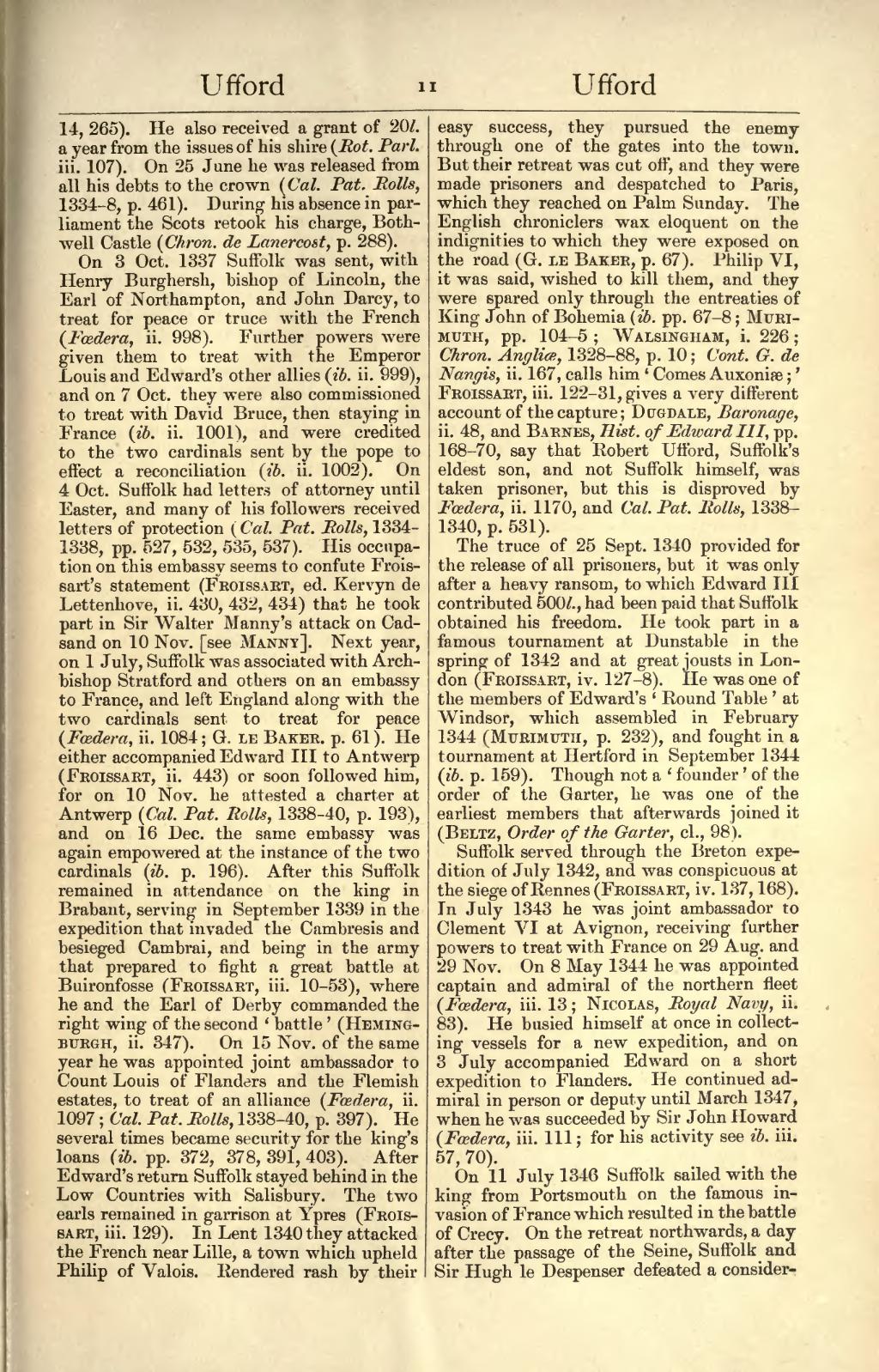14, 265). He also received a grant of 20l. a year from the issues of his shire (Rot. Parl. iii. 107). On 25 June he was released from all his debts to the crown (Cal. Pat. Rolls, 1334–8, p. 461). During his absence in parliament the Scots retook his charge, Bothwell Castle (Chron. de Lanercost, p. 288).
On 3 Oct. 1337 Suffolk was sent, with Henry Burghersh, bishop of Lincoln, the Earl of Northampton, and John Darcy, to treat for peace or truce with the French (Fœdera, ii. 998). Further powers were given them to treat with the Emperor Louis and Edward's other allies (ib. ii. 999), and on 7 Oct. they were also commissioned to treat with David Bruce, then staying in France (ib. ii. 1001), and were credited to the two cardinals sent by the pope to effect a reconciliation (ib. ii. 1002). On 4 Oct. Suffolk had letters of attorney until Easter, and many of his followers received letters of protection (Cal. Pat. Rolls, 1334–1338, pp. 527, 532, 535, 537). His occupation on this embassy seems to confute Froissart's statement (Froissart, ed. Kervyn de Lettenhove, ii. 430, 432, 434) that he took part in Sir Walter Manny's attack on Cadsand on 10 Nov. [see Manny]. Next year, on 1 July, Suffolk was associated with Archbishop Stratford and others on an embassy to France, and left England along with the two cardinals sent to treat for peace (Fœdera, ii. 1084; G. le Baker, p. 61). He either accompanied Edward III to Antwerp (Froissart, ii. 443) or soon followed him, for on 10 Nov. he attested a charter at Antwerp (Cal. Pat. Rolls, 1338–40, p. 193), and on 16 Dec. the same embassy was again empowered at the instance of the two cardinals (ib. p. 196). After this Suffolk remained in attendance on the king in Brabant, serving in September 1339 in the expedition that invaded the Cambresis and besieged Cambrai, and being in the army that prepared to fight a great battle at Buironfosse (Froissart, iii. 10–53), where he and the Earl of Derby commanded the right wing of the second ‘battle’ (Hemingburgh, ii. 347). On 15 Nov. of the same year he was appointed joint ambassador to Count Louis of Flanders and the Flemish estates, to treat of an alliance (Fœdera, ii. 1097; Cal. Pat. Rolls, 1338–40, p. 397). He several times became security for the king's loans (ib. pp. 372, 378, 391, 403). After Edward's return Suffolk stayed behind in the Low Countries with Salisbury. The two earls remained in garrison at Ypres (Froissart, iii. 129). In Lent 1340 they attacked the French near Lille, a town which upheld Philip of Valois. Rendered rash by their easy success, they pursued the enemy through one of the gates into the town. But their retreat was cut off, and they were made prisoners and despatched to Paris, which they reached on Palm Sunday. The English chroniclers wax eloquent on the indignities to which they were exposed on the road (G. Le Baker, p. 67). Philip VI, it was said, wished to kill them, and they were spared only through the entreaties of King John of Bohemia (ib. pp. 67–8; Murimuth, pp. 104–5; Walsingham, i. 226; Chron. Angliæ, 1328–88, p. 10; Cont. G. de Nangis, ii. 167, calls him ‘Comes Auxoniæ;’ Froissart, iii. 122–31, gives a very different account of the capture; Dugdale, Baronage, ii. 48, and Barnes, Hist. of Edward III, pp. 168–70, say that Robert Ufford, Suffolk's eldest son, and not Suffolk himself, was taken prisoner, but this is disproved by Fœdera, ii. 1170, and Cal. Pat. Rolls, 1338–1340, p. 531).
The truce of 25 Sept. 1340 provided for the release of all prisoners, but it was only after a heavy ransom, to which Edward III contributed 500l., had been paid that Suffolk obtained his freedom. He took part in a famous tournament at Dunstable in the spring of 1342 and at great jousts in London (Froissart, iv. 127–8). He was one of the members of Edward's ‘Round Table’ at Windsor, which assembled in February 1344 (Murimuth, p. 232), and fought in a tournament at Hertford in September 1344 (ib. p. 159). Though not a ‘founder’ of the order of the Garter, he was one of the earliest members that afterwards joined it (Beltz, Order of the Garter, cl., 98).
Suffolk served through the Breton expedition of July 1342, and was conspicuous at the siege of Rennes (Froissart, iv. 137, 168). In July 1343 he was joint ambassador to Clement VI at Avignon, receiving further powers to treat with France on 29 Aug. and 29 Nov. On 8 May 1344 he was appointed captain and admiral of the northern fleet (Fœdera, iii. 13; Nicholas, Royal Navy, ii. 83). He busied himself at once in collecting vessels for a new expedition, and on 3 July accompanied Edward on a short expedition to Flanders. He continued admiral in person or deputy until March 1347, when he was succeeded by Sir John Howard (Fœdera, iii. 111; for his activity see ib. iii. 57, 70).
On 11 July 1346 Suffolk sailed with the king from Portsmouth on the famous invasion of France which resulted in the battle of Crecy. On the retreat northwards, a day after the passage of the Seine, Suffolk and Sir Hugh le Despenser defeated a consider-
